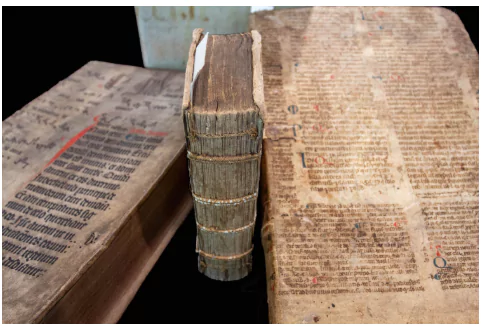Recently, the Union Budget 2025-26 introduced the Gyan Bharatam Mission.
About Gyan Bharatam Mission

- Aim: To survey, document, and conserve India’s vast manuscript heritage.
- Focus Areas: This mission primarily targets manuscripts held by academic institutions, museums, libraries, and private collectors to ensure their systematic preservation.
- Objective: To cover over one crore manuscripts, guaranteeing their long-term preservation and accessibility for future generations.
- Additionally, it aims to promote India’s rich literary and intellectual traditions on a global platform.
- Revival of NMM: Through this initiative, the government is making a significant effort to revive the National Manuscripts Mission (NMM), which was launched in 2003 but remained largely inactive.
- Budget Allocation: The financial allocation for the National Mission for Manuscripts (NMM) has seen a significant increase from ₹3.5 crore to ₹60 crore in the Union Budget 2025-26 to accommodate the Gyan Bharatam Mission.
- Implementing Ministry: The Ministry of Culture is responsible for implementing and overseeing the execution of this initiative.
Enroll now for UPSC Online Course
What is Not a Manuscript?
- Lithographs, which involve drawing on stone and then transferring the image to paper, as well as printed volumes, do not qualify as manuscripts.
|
What are Manuscripts?
- Definition: Manuscripts refer to handwritten compositions that may be inscribed on materials such as paper, bark, and palm leaves.
- Classification Criteria: To qualify as a manuscript, a document must be at least 75 years old and hold scientific, historical, or aesthetic value.
- Example: One of the most well-known Indian manuscripts is the Bakhshali Manuscript, dating back to the third or fourth century A.D. This ancient mathematical text, written on birch bark, is considered the earliest recorded example of the use of zero.
- Themes: Manuscripts can cover a wide range of subjects, including history, religion, literature, astrology, and agricultural practices.
- Estimated Count in India: India is home to an estimated 10 million manuscripts written in over 80 ancient scripts.
- Scripts Used: Some of the prominent ancient scripts include Brahmi, Kushan, Gaudi, Lepcha, Maithili, Grantha, and Sharada.
- Language Distribution: Approximately 75% of these manuscripts are written in Sanskrit, while 25% are in various regional languages.
Check Out UPSC CSE Books From PW Store
Other initiatives for manuscript conservation in India
- Asiatic Society of Bengal (1784): Established on January 15, 1784, by Sir William Jones, this institution is a pioneer in manuscript conservation. It actively digitizes ancient manuscripts to ensure their preservation.
- National Library of India, Kolkata: As India’s largest library, it houses approximately 3,600 rare and historically significant manuscripts, contributing significantly to manuscript conservation.
- National Manuscripts Mission (NMM) (2003): Launched by the Ministry of Tourism and Culture, this initiative aims to identify, document, and conserve India’s vast manuscript heritage. It collaborates with various institutions for digitization and preservation efforts.
Ready to boost your UPSC 2025 preparation? Join PW’s UPSC online courses today!
![]() 4 Feb 2025
4 Feb 2025


